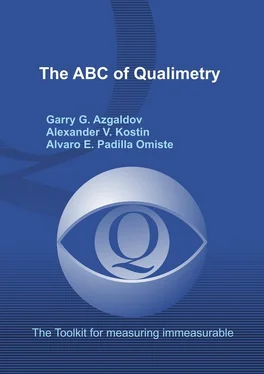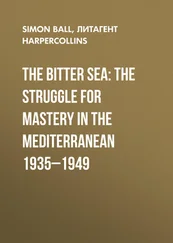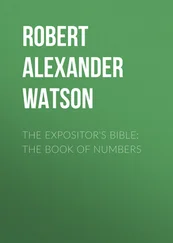Object quality control : the transfer of an object from a given state k 1 K to a future state k 2 Kat Δ K K PRE with in Δ T PRE (To rephrase it, to control the quality of an object is to ensure in the object a pre-set quality variation Δ K K PRE with in a pre-set time Δ T PRE ).
It follows from this definition that if any of these conditions were not met (e.g., indefinite timeΔT? instead of pre-set time Δ T PRE or in definite quality variation Δ K K? instead of pre-set quality variation Δ K K PRE is used) it would be improper to refer to it as quality control. In actual fact a different process is in progress. Table 1 shows different processes and their relation to the quality control process.

Table 1. Kinds of processes related to variation in the quality of objects. NOTE: Lines 10 and 11 represent situations, in which quality control in the ordinary sense is indeed exercised
Table 1 lists twelve situations differing in their combinations of Δ K K (quality variation) and Δ T (time variation). Each has an associated process type related to quality variation, from total uncertainty to quality control, which may vary within pre-set limits within a pre-set time.
Regrettably, in practice the term quality control is frequently applied to processes that can at best be described as quality improvement (see, e.g., line 4 above).In these processes (which in most cases concern industrial products) the value of an object’s property index could be improved by so many per cent within a pre-set time; e.g., the life of a component part could be increased by 30%.It is then concluded that the quality of the object improved by the selfsame 30% supposedly as a result of quality control.
There are two principal fallacies here. One is that the magnitude of increase in the value of the quality index was determined incorrectly, taking no account of the fact that an improvement in the value of a property of an object by α % almost always leads to an improvement in its quality index by β% (with α<���β).
The second fallacy is neglect the following: a quality improvement in one property of an object will result in an improved quality index of the object to the extent that none of its other property indices has deteriorated. Yet, this is a fairly common occurrence. Let us suppose that in the above case a 30% increase in the life of a component part is often accompanied by an increase in its mass. This leads to a deterioration of its “product mass” property by so many percent. Unless we make a qualimetric calculation we cannot say a priori whether – and by how many per cent – the quality of the product deteriorated or improved . (Proofs of both these assertions are to be found in books on theoretical qualimetry; see, e.g., [2]).
Therefore, it often happens in practice that the term quality control is applied to processes which, in control theoretic terms, cannot be considered quality control and, not infrequently, cannot be even called quality improvement because in reality they only ensure some indefinite quality variation (see lines 2 and 5 in Table 1 above).
The grey background in Table 1 is used to highlight two lines, 10 and 11, which represent the criteria to be met if we are to have a real quality control process. Line 10 describes the conditions under which, as common sense tells us, quality control is really achievable. That is to say, it is about a quality improvement is achievable to a pre-set extent within a pre-set time.
The case introduced by line 11 also belongs to control processes, though it is less apparent in the usual sense. Its only difference from case 10 is that the latter achieves a quality improvement (accordingly, ΔK K > 0), whereas in case11 no improvement is envisioned, the only intention being to keep quality from deteriorating within a pre-set time period, i.e., to set it at a constant level, ΔK K = 0).
The process described in line 12 is also related to quality control is totally unobvious to common sense. In pure theory, however, one can imagine a situation where the goal is not to increase but to decrease the quality of a product within pre-set limits and within a pre-set time, e.g., in order to cut production costs so as to boost demand. Since this is more academic than a real-life situation the respective line (12) in Table 1 was not highlighted with grey.
The foregoing interpretation of quality and quality control suggests that if we are to control quality we must be able to calculate the values of Δ K K . To do it we must, in turn, be able to quantify or estimate quality using its index K K . Consequently, we need a tool for the quantification of quality, which is provided by qualimetry.
There were also other factors, which made the appearance of qualimetry necessary, even inevitable. They will be discussed in the section that follows.
1.1.3. The Origin, Growth and Future of Qualimetry
1.1.3.1. The Reasons Behind the Rise of Qualimetry as a Science
Qualimetry is a consequence of knowledge quantification
The term qualimetry (from the Latin quale, “of what kind”, and the Greek μετρεω , “to measure”) was initially applied to a scientific discipline studying the methodology and problems of quantitative assessment of the quality of various objects, mainly of industrial products [3]. By 1970 enough experience had accumulated to permit a thorough investigation of qualimetry, its subject matter and its relations with various scientific fields. At the same time there was a growing awareness of the need to expand the scope of qualimetry from product quality (which was the focus of some researchers) to the quality of objects of whatever nature, including socio-economic objects such as the quality of life.
When the term (and the respective concept) was first used it seemed unexpected, almost fortuitous; some still regard it so.
However, it would be wrong to speak of the fortuity of qualimetry. On the contrary, its appearance should be seen as one of the many perfectly natural signs of the general broadening of the scope of quantification and the use of quantitative methods in scientific and, generally, cognitive activities at large.
The universal and imperative nature of this tendency to expand the use of quantification as a major tool of cognition was succinctly stated by Galileo, who said “Measure what is measurable, and make measurable what is not so.” The Russian Mathematician D. B. Yudin expressed nowadays essentially the same idea: “Quality is a yet unknown quantity”.
Many great minds were aware of the important influence that mathematics, as a general framework of quantification techniques, has exerted on the development of science.
K. Marx was of the opinion that a subject could be called a science if it had a mathematical foundation. A century before him, I. Kant wrote in his Metaphysical Foundations of Natural Science , “I maintain, however, that in every special doctrine of nature only so much science proper can be found as there is mathematics in it”. Three centuries before Kant, Leonardo made a similar statement: “No human investigation can be called real science if it cannot be demonstrated mathematically”. Five centuries before Leonardo, in the 9 thcentury, the famous Arab scientist Abu Yusuf Ya’qub ibn Ishaq al-Kindi, who saw in mathematics the basis and prerequisite of all science, including philosophy and natural history, pursued a similar line of thought. Another thirteen centuries earlier the Greek philosopher Xenocrates of Chalcedon expressed the ancients” idea of mathematics in the following maxim: “Mathematics is the handle of philosophy”. Dozens of years before Xenocrates, or 2300 years before our time, his teacher Plato said, “Exclude from any science mathematics, measure and weight, and it is left with very little”.
Читать дальше













